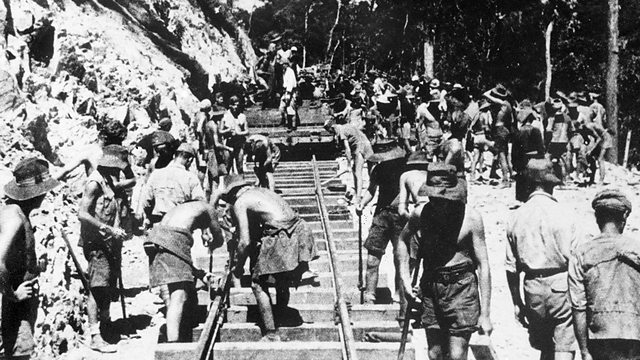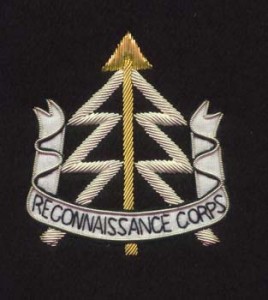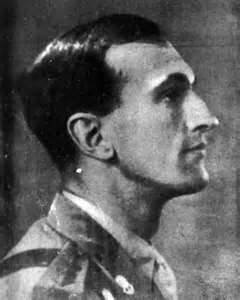The Man Who Wouldn’t Surrender
by
Mark Felton
Roy Pagani tore along a jungle trail as fast as he could go. The heat was stifling and sweat poured down his face. The vegetation was alive with the chirruping and squawking of insects and birds. Mosquitos buzzed around his head as he panted and hurried on. The Japanese would not be far behind and capture was not an option. The young British soldier was determined to walk a thousand miles to India.
Pagani was born in London in 1915 and joined the army in 1933. He had served in India before going to France with the BEF in 1939. Because he spoke fluent French he found work as an interpreter. After evacuation from Dunkirk, Pagani joined the elite Reconnaissance Corps. Ordered to Singapore, Pagani’s unit saw action in the last desperate battles around the city before being ordered to surrender on 15 February 1942 with the rest of General Percival’s army.
Corporal Pagani approached his commanding officer, Major D.R. Lullineux, on the 15 February and told him that he wanted permission to escape. Lullineux readily gave his permission and also wished him good luck, for the odds of getting away were extremely slim. Pagani went to the burning docks where he found several motor launches. He desperately tried to start the engines on several, but to no avail. Night began to fall. Then he spotted a 15-foot sampan and jumped aboard. The native craft had a rudder and small sail, but no engine. As Singapore burned, the sampan slowly moved across the calm water. Pagani slumped over the tiller and peered into the darkness, struggling to stay awake. He realised that if he was to stay on course he would have to go ashore and get some rest. He landed and promptly fell into a nervous sleep.
Pagani awoke refreshed the next evening and continued south. Travelling by night to avoid detection he worked his way through a chain of small islands. Before dawn on 17 February Pagani landed again. In the evening Pagani sailed south to another jungle-covered island and made contact with a local Chinese merchant, who kindly provided him with rations. Before dawn on 19 February Pagani beached his sampan on Moro Island where he discovered a small party of British soldiers. They had been sent to assist fugitives escaping from Singapore to get to Sumatra in the Netherlands East Indies. ‘The British soldiers advised Pagani to go to Sumatra because the chances of surviving an open ocean voyage to Australia in such a small boat were slim.’
‘During the second night he was caught in a terrible storm. He lowered the sail and secured the boat. But as the storm intensified waves repeatedly broke against the side of the boat.’ For hours Pagani was tossed about like a cork on the roiling ocean as the wind howled and salt spray lashed his face. Then the storm abated. Peering into the growing light Pagani espied low-lying land a mile away. He hoisted sail and tacked the sampan into the mouth of a wide river. ‘After creeping up the river for several hours he finally saw a small group of men. They waved that he should come ashore. They were British soldiers…He had made it to Sumatra…’
Pagani, along with thousands of others, crossed Sumatra to the east coast port of Padang where evacuation ships were arriving to take them to India. For nearly two weeks Pagani waited to board a transport as the Japanese headed for the port. On 15 March, with Japanese infantry close by, Pagani joined a motley assortment of beached British sailors. They located a small steam tug and two days later, with the tug full of provisions, they departed. But disaster struck. The Japanese had taken the town moments before and soldiers fired a machine gun across the tug’s bows, ordering it to return.
Five hundred British servicemen, along with 700 Australians and Dutch, were taken prisoner and herded into a local barracks. After a few days, the Japanese organised the POWs into groups and shipped them to Mengui, Burma. They were to become slave labourers on the infamous Burma-Thailand Railway.
The railway cost the lives of 90,000 Asian labourers and 16,000 Allied POWs (including 3,585 Britons). Pagani was held in a camp for several months until on 21 October 1942 the Japanese transported the POWs to Moulmein Station and the following day a train took them thirty miles to Thanbyuzayat, the main junction for the Burma-Thailand Railway. Pagani and the others were expected to construct the junction at Konkuita in Kanchanaburi Province, Thailand and would be based at the infamous 18KM Camp for the duration, under the brutal command of Lieutenant-Colonel Nagatomo.
Pagani realised that every day he spent as a slave labourer on the railway would make escape less likely. He quickly formulated two escape plans. The first involved heading ten miles west to the Bay of Bengal. At the coast Pagani would steal a boat and then sail along the Burmese coast to India. If he was unable to find a boat, Pagani’s second plan involved walking 1,000 miles overland through Burma to India. His epic trek would take him through some of the toughest country on earth where tropical diseases abounded, and he could not speak the local languages. ‘Pagani had prepared himself. He was now as brown as a native and his feet were hard for the trip (to pass as a native he would have to travel without shoes). He had a full brownish-red beard. He looked like a Burmese native, and the Japanese would be looking for an Englishman.’
Pagani decided to escape two days later. When dawn broke on escape day, Pagani was already up and he quickly breakfasted on a small bowl of rice gruel before attending the tenko roll call. The Japanese routinely beat any prisoners who reported for sick parade. After a short bashing the offending prisoner was handed a changkul, a native hoe, and ordered out unescorted to join a work party beyond the main gate. Pagani duly reported sick, was beaten, handed a changkul and ordered out. When he was about 100 yards beyond the main gate, with his changkul over his shoulder, he stepped off the track and into the jungle. He would not be missed until evening tenko, and the Japanese would not start looking for him until the following morning.
Pagani reached the coast in four hours but failed to find a boat. As he was only ten miles from the camp Pagani fell back onto Plan B – walking to India. He set off in a northeasterly direction until he reached the railway and followed this north towards Moulmein. He reached Thanbyuzayat, a small village near Moulmein later that afternoon. Quickly donning an Indian pagri turban, he rubbed dirt into his legs and face in an effort to further disguise his European features. He then set off down the village’s main street. Suddenly, a Japanese patrol appeared. ‘He overcame the natural instinct to run and instead casually walked toward a house to urinate. Since his survival depended on passing as a native Pagani followed the local custom.’ The Japanese soldiers strolled by, barely casting him a glance. Shortly after Pagani ducked into an empty shop stall and fell asleep.
He awoke after sundown and set off for the railway line towards Moulmein. As the first light of dawn began to spread across the horizon Pagani came to a small shack set on the edge of paddy fields where he rested until darkness fell. Pagani walked all through the next night until he happened upon another wooden hut at dawn. The Indian inside offered to help him but warned Pagani against entering Moulmein, which was swarming with Japanese. Instead, it was agreed that the Indian’s brother would ferry Pagani across the Salween River.
After crossing the river Pagani trekked for two days until the wild jungle gave way to an ordered plantation look. He crept through the trees until he discovered several well-kept buildings. ‘The place had an unmistakable feel of prosperity. He surmised that the people had prospered under the British and most likely did not look upon the Japanese with good favour.’ Knocking on the front door, a servant instructed Pagani to wait. Then a well-dressed young woman speaking perfect English invited the filthy fugitive into her elegant home. Her father, Po Thin, was a wealthy Karen timber merchant. When Pagani was introduced to Po Thin he recounted his many escape attempts since Singapore and his imprisonment on the railway. Po Thin was impressed, and agreed to help him reach Allied lines. He knew of an eccentric British major who was busy training Karens up in the hills to fight the Japanese.
Pagani eventually reached the small village of Molopa high in the Karen Hills. The village contained an extraordinary mixture of soldiers and civilians. Alongside the Karens were Indians and Gurkhas. A tall native walked towards him smiling and announced cheerfully: ‘Hello old chap, how are you?’ in clipped public school English. ‘The man introduced himself as Major Hugh Seagrim. He grasped Pagani’s hand and in a voice choked with emotion kept telling him how glad that he was that he had come.’ Thirty-three-year-old Seagrim had joined Force 136, the Far Eastern arm of SOE, and been tasked with training the loyal Karens to fight the Japanese. At 6 feet 4 inches tall Major Seagrim had earned the affectionate nickname “Grandfather Longlegs” from the Karens. His sabotage activities had already earned him a DSO and a MBE.
Pagani and Seagrim both realised that the Japanese would be searching for their missing prisoner. Seagrim decided that henceforth Pagani would be known as “Corporal Ras”, so if recaptured the Japanese would not link him with their missing Corporal Pagani. Seagrim delighted in tutoring Pagani on the hill tribes of Burma, and he respected the corporal for his bravery and resolution in escaping from the Japanese. Pagani said that Major Seagrim was the finest officer that he had the pleasure to encounter during the war. Seagrim made Pagani his commander for his southern area of operations – the young corporal became a guerrilla leader by chance. After many raids Pagani was sent by Seagrim on a mission to contact Allied forces in the Prome region on 9 April 1943. The next time the two men would encounter each other would be under very different circumstances.
After leaving Seagrim, Pagani travelled north with some of Seagrim’s heavily-armed guerrillas. His intended destination was a group of friendly Karen villages in the Arakan Yomas coastal region. He would have to cross Burmese territory, including the mighty Irrawaddy River. He discharged his Karen guards except one guide. The next day hostile Burmese captured his guide. Alone once again, Pagani continued on towards the Irrawaddy. Two days later, while resting in a Burmese pagoda, he dashed outside to see a formation of American B-25 bombers on their way to attack the city of Prome, 150 miles north of Rangoon. Pagani felt it a good idea to disassociate himself from the British Army, as the Japanese might still manage to make the link between “Corporal Ras” and their missing Corporal Pagani. Thinking of his baby son, Terry Ashton Melvin Pagani, he decided to re-invent himself as a shot down American air force officer named “Lieutenant Terry Ashton Melvin”.
The next day Pagani arrived on the east bank of the Irrawaddy. He spent a few hours searching for a boat but realised that his only hope was to swim across. The current was strong and unpredictable. Pagani stepped into the warm waters and began to strike out for the western bank in the moonlight. ‘About 150 yards from the bank he was caught in a strong undertow that, coupled with the weight of his gun and ammunition, threatened to pull him under. He dumped his gun and spare ammunition and floated downstream, but the current pushed him back onto the east bank of the river.’
Exhausted, Pagani was spotted by two Burmese in a fishing boat, who picked him up. But a crowd of Burmese ordered the fishermen to hand Pagani over. They wanted to present him to the Japanese in return for a small reward. Amid much commotion Pagani was bound with rope. He managed to break free and dashed for the nearest jungle, but he was shot and wounded. ‘Beaten and bloody, Ras thought of his wife and young son and his promise that he would return home. They would never know what happened to him.’
Pagani was transported downriver to a Japanese guard post and handed over. His wound was perfunctorily treated before he was questioned. He told the Japanese that he was a USAAF officer who had been shot down the night before during a raid on Prome. Transferred to a hospital, he slowly recovered his strength. The Japanese interrogated him in more detail. ‘He explained his native clothing by saying that his uniform had caught fire, and the natives had given him what he was wearing.’ After six weeks Pagani was sent to Rangoon. On arrival Pagani was handed over to the brutal Kempeitai military police.
Placed in a tiny cell with five other prisoners, Pagani witnessed prisoners being brutally interrogated. Pagani was dragged into a room containing two Japanese NCOs, each armed with a bamboo cane. One asked the questions, while the other beat Pagani mercilessly. Pagani stuck to his cover story. Next, he was dragged into a second room where two more interrogators were waiting. One of the interrogators was a junior officer, and in between questions he would beat Pagani with the back of an unsheathed samurai sword. Sometimes he levelled a cocked pistol at Pagani’s head and dry fired it. Finally, Pagani was bundled into a third room where he was tied to a flat surface with his head positioned beneath a dripping tap. After a while each drop of water that hit his forehead felt like a hammer. At some point the questions and the agony abruptly ceased and Pagani was dragged back to his grimy cell to nurse his wounds.
Pagani’s endurance paid off, and he was cleaned up and sent to Rangoon Jail. The prison held nearly 600 Allied prisoners of war in appalling conditions. One of the prisoners was Major Seagrim. His unit of Karen guerrillas was steadily worn down in combat, and the Japanese had made horrific retaliatory attacks against Karen villages. Seagrim could not abide the cruelties that were inflicted upon his beloved Karens and on 15 March 1944 he voluntarily surrendered himself to the Japanese after he had received assurances that he would be accorded POW status. The Kempeitai did not torture Seagrim as it seems that even the Japanese had some respect for him. On 2 September 1944 Pagani looked up from his work party as a Japanese Army truck drove past. In the back of the truck he saw a tall Englishman and seven Karens. ‘As they started through the breezeway towards the front gate the Englishman saw Pagani, gave him a big smile and waved to him. It was a few moments before Pagani realised that the Englishman was his beloved Major Seagrim.’ The Japanese broke their promise. Seagrim and comrades were court-martialled, sentenced to death and executed by firing squad later that day. Seagrim was posthumously awarded the George Cross in 1946.
Pagani spent the remainder of the war labouring on the Rangoon Docks. The death rate in the camp was later determined to have been between 20 and 25% of the white prisoners. Roy Pagani was liberated on 28 April 1945 and later awarded the Military Medal. He finally made it home to his wife and young son.
For more thrilling stories like this, read:


